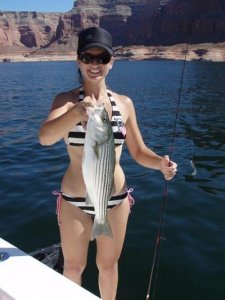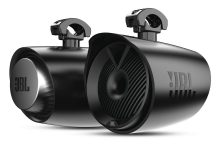
Lake Elevation: 3628 Water Temperature 77-80 F
The theme for this report is “good fishing”. That takes on different connotations in Lake Powell when compared with most other fisheries. Anglers at Powell usually catch large numbers of fish while those fishing other waters are content with fewer fish. Both fishing experiences are fun but expectations are different.
The immense size of the lake provides space for innumerable predator fish that are often forage limited. Hungry fish are easy to catch. Infrequently the lake balance swings away from being predator heavy and forage fish are more abundant. Flourishing forage is normal in most waters but when that happens at Powell an adjustment in fishing attitude is required.
Stripers drive the Lake Powell fishery. They eat early and often which makes them easy to find while they are roaming and searching for food. This year feeding is easy in the northern lake. Stripers are fat. Meals are provided in a short order without great effort. Roaming and searching for food is limited.
To be successful in these conditions feeding habits must be understood and exploited. Stripers feed for the first and last two hours of daylight. They are nocturnal and will feed in dark periods as well. The prized surface feeding events (boils) occur consistently during the dawn and dusk period and randomly during the day. Wind blows away the boil and stripers just feed at depth instead of the surface. The strategy is to be in postion to find a boil when the sun comes up.
Recently the southern lake is “better” for boils. There are less shad, making stripers search harder and boil more often. Cruise the lake from Wahweap to Rainbow for a chance to see a morning boil. The mouth of the San Juan may be the most consistent boil spot now but the channel from San Juan to Bullfrog is also productive.
The northern portions of the lake (Hite and San Juan) are still forage-heavy with less surface action. Fishing is great for bass along the rocky shore and in the brushy coves. If fishing the northern lake, target bass and take advantage of a striper school when they pop to the top or cross the screen of the graph. The best technique is the jigging spoon placed immediately in the fast moving school. Catch them quick because they move on in a short time.
What has been described here is Lake Powell fishing success being much like most other fisheries. It should be enjoyed knowing that fish are having an easy time right now. But these conditions will not last long. Shad will be consumed in huge numbers. The shad spawn next spring will be small due to the high numbers of shad competing with each other for food. The end result will be a normal Lake Powell high success year in 2009 with big fish being common. That will be a peak year to be remembered. Plan now to fish the lake in 2009.
For this week we have to be satisfied with only catching 10-30 fish per day, unless bass fishing and then the numbers go up. I know this is “slow” fishing by Lake Powell standards, but today’s sacrifice will lead to a brighter tomorrow.































